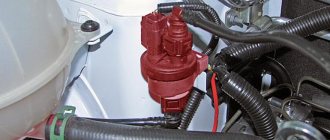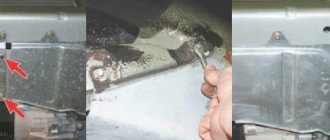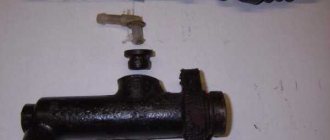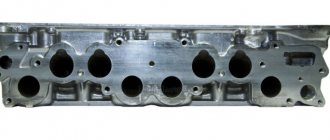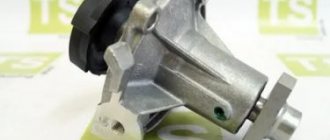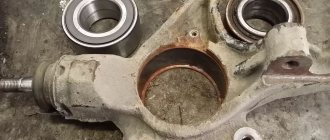Replacing the canister and canister purge valve
Note.
The location of some parts may differ slightly depending on the vehicle modification. This page shows an example of a Euro-3 engine. Replacement on a Euro-2 engine is shown here. Removing the evaporative emission system canister
We remove the adsorber for replacement if the seal of its housing is broken (determined by the smell of gasoline or visually).
Remove the pipe and spare wheel support. (see here)
The absorber is located under the brake master cylinder. For clarity, the work is shown with the master brake cylinder and vacuum brake booster removed.
Press the tube tip lock.
Using a slotted screwdriver, loosen the clamp securing the fuel vapor removal hose from the adsorber to the purge valve.
. and remove the hose from the adsorber fitting.
Using the “10” head, loosen the tightening of the adsorber fastening clamp.
. and remove the adsorber from the engine compartment.
An adsorber with a tube for supplying fuel vapor to it.
Install the adsorber in reverse order.
REMOVAL OF THE CANSORBER PURGE SOLENOID VALVE
The absorber purge valve is mounted on the intake manifold bracket.
We are working to replace the valve.
By pressing the lock of the engine control system wiring harness block, disconnect the block from the canister purge valve.
Use a Phillips screwdriver to loosen the clamp securing the fuel vapor supply hose from the adsorber to the purge valve.
. and remove the hose from the valve fitting.
Using a slotted screwdriver, loosen the clamp securing the fuel vapor supply hose from the valve to the receiver.
. and remove the hose from the other valve fitting.
Insert a slotted screwdriver into the groove of the valve and press the tongue of the bracket.
. move the valve from the bracket.
For clarity, the two bottom photos show the removal of the valve on a dismantled bracket.
Using a slotted screwdriver, press out the tongue of the bracket.
We install the solenoid valve for purge the adsorber in the reverse order.
Video
Source
Replacement Instructions
Replacing the purge valve
If the valve knocks loudly, it needs to be adjusted. For this purpose, it has an adjusting screw. Its head is filled with epoxy. The polymer prevents the screw from unscrewing spontaneously. A malfunction in the electromagnet power circuit can be eliminated by cleaning the connector contacts.
The work is performed with one screwdriver in the following order:
Replacing the adsorber
In addition to a screwdriver, you will need a 10mm wrench. The work order is as follows:
Removing the adsorber from the fuel system is unacceptable. This part compensates for pressure differences that occur during cooling and heating of the gas tank. In addition, the operation of the purge valve is controlled by the engine ECU. Therefore, you cannot simply plug the hose outlet - the on-board computer will generate an error. If you leave the tube unplugged, dust and dirt will be drawn into the gas tank.
Chevrolet Niva Vossnaya › Logbook › Canister valve, speed, toe.
I. Speed during coasting and idle, adsorber valve.
I'm lucky for this, recently we were talking about turnover in one of the topics. This prophetic question probably affected my car. In general, my revolutions went up, now they not only hung after the gas pedal at 1.4-1.6, but also began to jump between 1.6-1.9. I just noticed how there was a severe degradation of revolutions over the course of a month. At the first sign, I changed the throttle body gasket, but nothing changed. I bought another gasket made of better material than paper, but nothing has changed. I had 2 in my stash, not counting what was on the IAC throttle, one of them was completely new. I tried everything, nothing changed. I brought the computer to the garage, but forgot the Internet. And here I am sitting in my car by the garage, spinning thoughts in my head. And I realize that I touched the vacuum hose when I changed the damper for the first time, I cut this unfortunate hose to eliminate cracks. I open the hood, move the hose, and it whistles, the hose is completely stiff and literally crumbles from any physical impact on it. When I removed the hose, I simply broke it like a stick.
I'm changing it for a new one, as they said in the Amsterdam store)) 120r 0.5m, in general I bought it for another story, but it fit perfectly. I make a circle around the line of garages, the revs are again high but they no longer twitch, after 3-5 seconds they drop to 1000 or 1200 and hang. I started checking all the hoses, sniffing them out, removing them, plugging them in with my fingers. As a result, I removed the hose from the adsorber valve, screwed the bolt in there, and after starting the engine kept a clean 800-840 rpm, I haven’t seen that for a long time, the gearshift knob just froze, the engine whispered evenly. I drove around the line of garages and everything was clear, the car immediately dropped the revs to 800. Indeed, I haven’t heard the adsorber chirping for a long time, although I remember from memory that now it is always silent. The adsorber valve “Utes” 2112-1164200-02, has covered 181 tons of mileage since the production of the car “12.04”.
I tried to blow it out, I blew it out, according to the information on the Internet there shouldn’t be any blowing, in general the sensor died. After driving for a couple of days without the valve, the engine just whispers cool, but everything needs to be returned to its place. There are no such valves for sale, I bought some kind of noname “Made in Russia” 250, as we said, a large store and everything comes to us in large boxes almost from AvtoVAZ.
I pulled out the old one using screwdrivers, everything under the hood is warmed up, the fit shouldn’t burst. I put on a new one, pressed it, and the shards flew out.
Either it’s old plastic or I’m a tinkerer... I came across a new one and it’s holding up, I even drove it for a couple of days and it didn’t fall out. To calm my soul, I drilled holes and tied them with a tie for security.
At the first start, such hard clicks were heard from under the hood, I already thought that I would take this valve back, it was immediately clear that you definitely need to buy it with the markings of at least some factory that value their quality! After a couple of days I forgot about it, and even if it should rustle, it should only be at revs. The car, at any idle speed, be it coasting or parking, maintains an average of 800-840 bk.
II. Convergence
After replacing the steering tip, the steering wheel came off, I went to the alignment for 500 rubles, everything was set, now the car is happy again and drives cheerfully)
PS:
I don’t blame the adsorber hose and valve for anything, their service life is over, and the result is positive. The hose has run for 7 years or 51t.km.
Source
Is it worth turning off the adsorber, pros and cons, possible consequences
Before turning off the adsorber in a car, it is important to understand how much this will affect the performance of the vehicle, including environmental ones, as well as driving safety.
In the article we will analyze the purpose and operating principle of the adsorber, where it is established, when it needs to be changed and whether it is possible to turn it off and drive without the device, how to properly remove it on a VAZ 2110, 2112, 2114, Lada Priora, Grant, Largus, Gazelle and whether it is necessary to flash the ECU after shutdown devices.
Purpose and principle of operation
Adsorber - is a container filled with activated carbon, which acts as a filter element. This element is the main part of EVAP - Evaporative Emission Control (gasoline vapor recovery system).
The system has been integrated into the fuel system of cars with Euro-2 standards and higher. Those. you won’t see an adsorber on a VAZ classic or even a 2108 model, not to mention Moskvich, Volga 3110, etc.
The goal is to reduce harmful emissions into the atmosphere and eliminate gasoline odors in the car interior.
But despite the simplicity of the design, in addition to the housing and the filter element, the adsorber consists of:
Fuel vapors accumulating in the gas tank must go somewhere. In old cars they escaped into the atmosphere through a special tube. In modern vehicles, fuel tanks are isolated from the external environment.
Gasoline vapor, through a separate outlet pipe, enters the adsorber and condenses there in the form of fuel, which is returned back to the tank or to the intake manifold. In the first case, the process occurs with the engine turned off, in the second - with the engine running.
As soon as the car starts, the ECU sends a signal to the solenoid valve. The latter opens and the activated carbon (sorbent) is purged. Fuel vapors are “extracted” from the sorbent and immediately enter a special receiver and then into the combustion chamber.
To find out more about what an adsorber is, follow the link.
Symptoms of a problem
The service life of the adsorber and valve, like any car part, is limited. Over time, the filter becomes clogged, compacted and prevents the free escape of vapors from the gas tank. The valve mechanism jams, the electromagnetic coil burns out or contact is lost in the connector area. This can be determined by indirect signs:
- High pressure in the fuel tank, expressed by hissing when the cap is unscrewed.
- The valve knock is too loud when you press the gas.
- Floating idle speed. There are many possible causes for this problem, but one of them is a faulty adsorber.
- Burning Check Engine light on the dashboard and diagnostic error codes.
- There is no click when the adsorber valve is turned on.
- The smell of gasoline in the cabin.
The valve can be cleaned or adjusted. Repair of the adsorber is not provided. The only way out is to replace it with a new one.
Where is it installed?
As a rule, the adsorber is installed under the hood on the right in the direction of travel of the car, for example, in the VAZ 2110 it is in the form of a barrel.
In other cars, it can be square and installed to the left of the engine (in the direction of travel), under the air duct (Lada Granta), the vacuum brake booster (some Nissan models) or in the radiator area. For VAZ 2114 it is located near the battery and air filter.
On the Volkswagen Passat B3, the adsorber is located under the air filter on the right side in the direction of travel.
Other vehicles - see your model's owner's manual.
Detailed video about the Shnivy adsorber:
Gasoline vapors form naturally in a car tank when the ambient temperature increases. To absorb them, modern cars are equipped with a gasoline vapor recovery system - EVAP. Maintaining normal pressure in the fuel lines, and, consequently, stable engine operation depends on its performance. One of the main elements of EVAP is the canister purge valve.
The element that accumulates gasoline vapors is an adsorber. It is located in the engine compartment and looks like a cylinder. It looks very similar to a fuel filter, but is larger and filled with activated carbon inside. It is in it that gasoline vapors accumulate, and along with them fine dust and dirt.
The latter prevent the passage of vapors that tend to enter the intake manifold and burn with the gasoline mixture when the engine is running.
Why do they refuse the adsorber?
Despite the advantages of this design solution, and these are: fuel economy, absence of odor in the cabin, reduction of harmful emissions into the atmosphere (although many do not care about this), the adsorber has a number of significant drawbacks, due to which many seek to disable it or completely remove it.
Disadvantages, they are also signs of malfunction:
Therefore, when a product fails, many people turn it off and remove it, or take a more complicated path - they open the case and replace the old activated carbon with a new one.
How to disable or remove the adsorber on a car and do you need to reflash the ECU?
You need to understand that when the adsorber is removed, the solenoid valve is turned off, which is directly connected to the controller and controlled by the latter.
This will lead to error p0443, which we already mentioned above. The tubes are also silenced, in particular the one that goes to the intake manifold.
What is the disadvantage of such a shutdown?
The fact is that through the tube that goes to the intake manifold, air is constantly sucked in; even in idle mode, the so-called small purge of the adsorber occurs. At high speeds from 1500 – 2000 and above there is a lot of purging.
In the ECU firmware, constant air leaks and the flow of fuel vapor are taken into account when forming the air-fuel mixture, despite the fact that all this goes past the mass air flow sensor, the causes of the malfunction of which can be found out by clicking on the link.
If you plug the pipe, which many people do, a certain amount of air will not flow into the intake manifold bypassing the ECU, but the latter still takes them into account.
That is, the controller takes into account one volume of air, but another (smaller) one actually enters. As a result, the amount of fuel is generated by the ECU based on more air than is supplied. This leads to an over-enrichment of the air-fuel mixture.
As a result, the engine does not work correctly, because the mixture is constantly over-enriched where it is and is not needed, and fuel consumption increases.
It is also worth talking about the transient mode of operation of the engine, which can manifest itself when approaching an intersection, a traffic light, lying to a policeman, at the moment when the gas is released.
At this moment, a failure may occur - a decrease in speed below idle. The engine seems to choke, it doesn’t have enough air, the reason is an over-enriched mixture. After a few seconds, the situation is resolved electronically.
Therefore, it would be correct to disable the adsorber in the following ways:
How to disable the adsorber on a VAZ 2110, 2112, 2114
Taking into account the recommendations above, we do the following:
With this scheme, when the valve opens, clean air enters the system, albeit without gasoline vapors.
We exclude the valve
This method is even simpler. We dismantle everything, including the valve. We put a fuel filter on the pipe coming from the gas tank, and we plug the pipe going to the intake manifold with a bolt and clamp.
The consequences of this method are described above, but this method also has the right to life.
As for Priora, Granta, Lada Largus, Gazelle and other cars, the absorber is turned off in similar ways as described above.
Toyota Chaser
It is worth considering one of the foreign cars, for example, the Toyota Chaser.
The shutdown principle is similar to the previous ones:
How to check the valve
In order not to struggle with symptoms in the future, the valve is checked periodically. You can notice that it is not working properly by its characteristic sounds. Many people think that the clicking sounds when an internal combustion engine is running are made by the rollers or timing belt, but a similar sound can also be produced by the adsorber valve when it is not functioning properly. In order to check whether it really makes the appropriate sounds, just press the gas pedal. If the sound does not change when you press the gas pedal, then this is the reason.
In order to understand how to correctly diagnose a device, you need special equipment.
In order to make sure that the adsorber valve is faulty, you can pay attention to the characteristic symptoms:
- When the engine is idling, there are noticeable dips;
- The inside of the car smells of gasoline;
- When the gas tank cap is opened, a hissing sound is heard;
- The engine runs poorly.


